october november 2025
Graphic novel…
Non-fiction
Essay
Cookery
Nature
Practical book
Arts… 18
Illustrated book
Fine arts
Music
Cinema

Essay
Cookery
Nature
Practical book
Arts… 18
Illustrated book
Fine arts
Music
Cinema
actes sud - l’an 2. Jens Harder, Gamma... visions. 6
actes sud bd - virages graphiques. Maëlle Reat , Murmures de cafés. 7
19,5 × 31,5 cm / 224 pages
>
> Gamma... visions is the fourth and final instalment of the ‘Great Story’ tetralogy.
> An impressive artistic achievement
> 1,400 pages and 16 years of work – that epitomises the extraordinary educational power of comic books.

Translated from German by Étienne Diemert
Having explored in the first three volumes the imagery that has been used to represent the evolution of the universe and the history of the human race, Jens Harder’s focus switches in this instalment to the future. How is our planet going to turn out? What fate is in store for us amid dramatic climate change and the advent of mass extinctions? What role will technology play in our survival? All of these questions and more are addressed in this final volume of his ‘Great Story’. A dazzling finale to this monumental oeuvre.
Born in 1970 in Weißwasser in the then East Germany, Jens Harder is a German comic book writer. In 1999, he co-founded of the Monogatari artists’ collective. His works are characterised by their ambitious blending of cosmology and the history of the human race, often without accompanying words. The French editions are published by Actes Sud BD / L’An 2. He is based in Berlin.
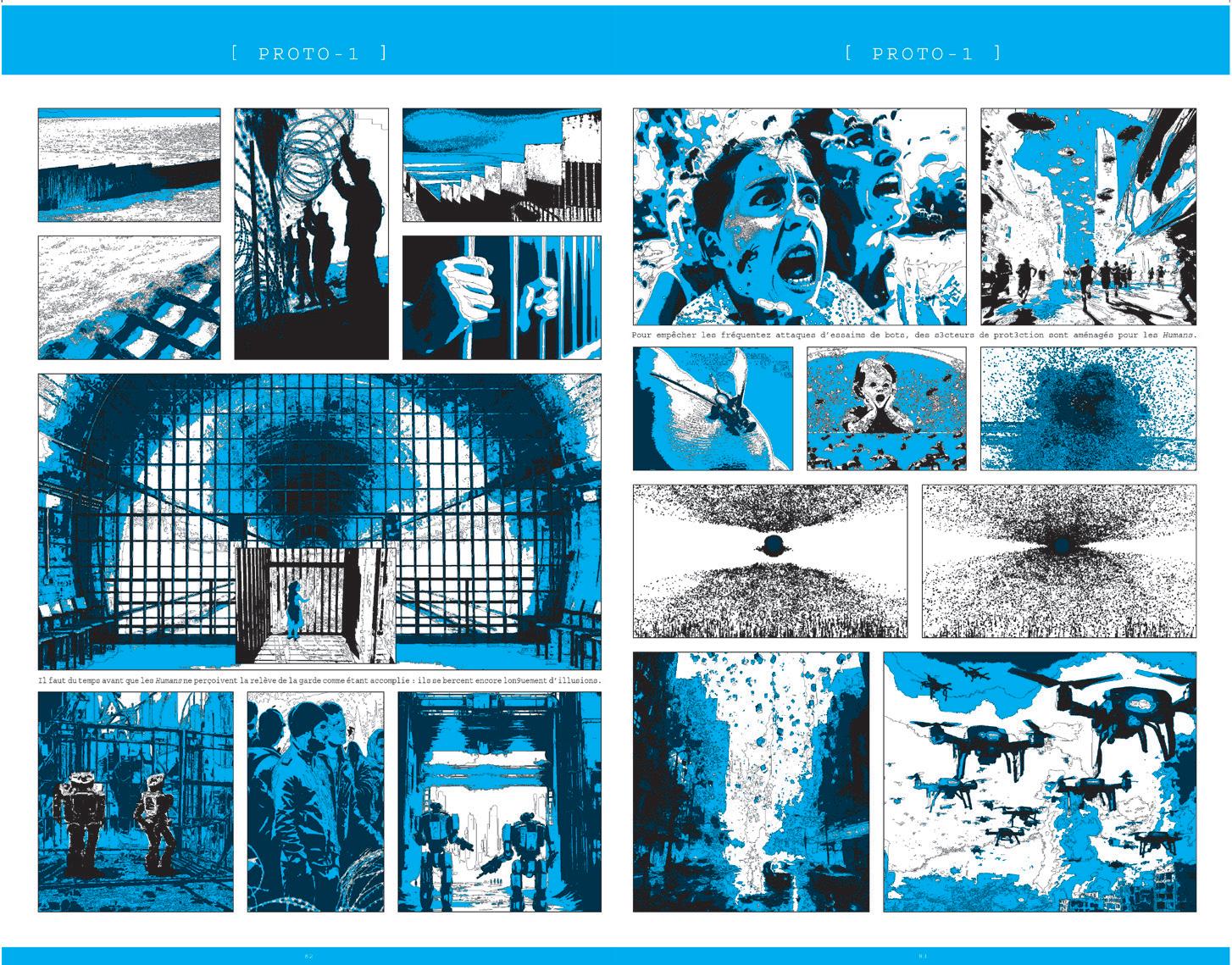
The rest of ‘Great Story’ series featuring new covers:

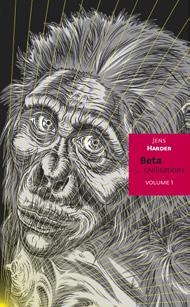

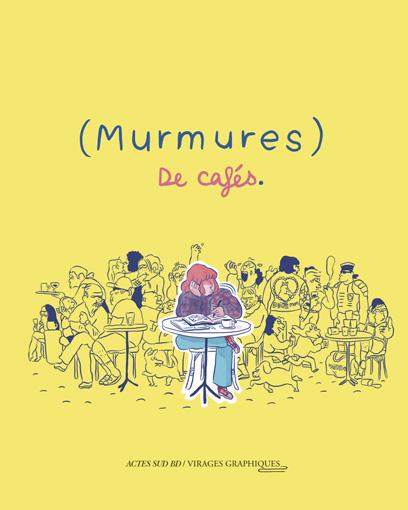
Murmuring 1. The soft continuous sound of human voices. 2. Several people quietly expressing an opinion.
In Maëlle Reat’s illustrations, murmurings rarely go unnoticed. Whether emanating from those standing at the bar or seated on the terrace, they make themselves heard over the general background noise.
A hilarious and impertinent collection of short sketches, Murmures de cafés showcases the author’s talent for capturing the juicy morsels of conversations and the burlesque side to the social interactions of every age group.
Maëlle Reat is a comic book writer and illustrator. Following on from Comme une grande (2022), Murmures de cafés is her second comic book to be published by Virages Graphiques.
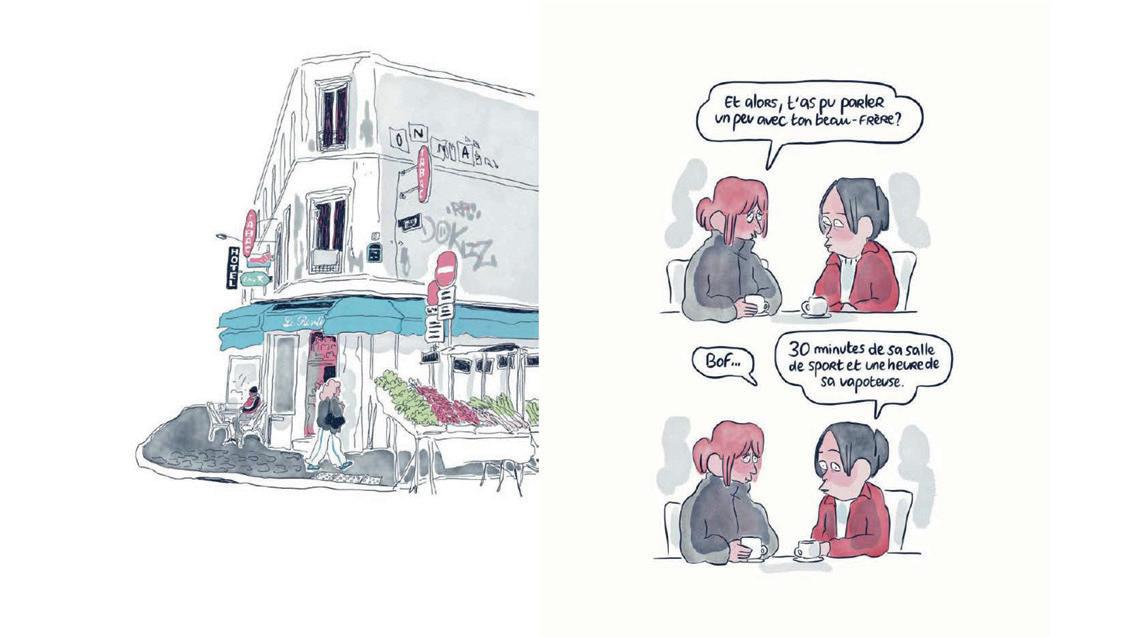


Visuel provisoire
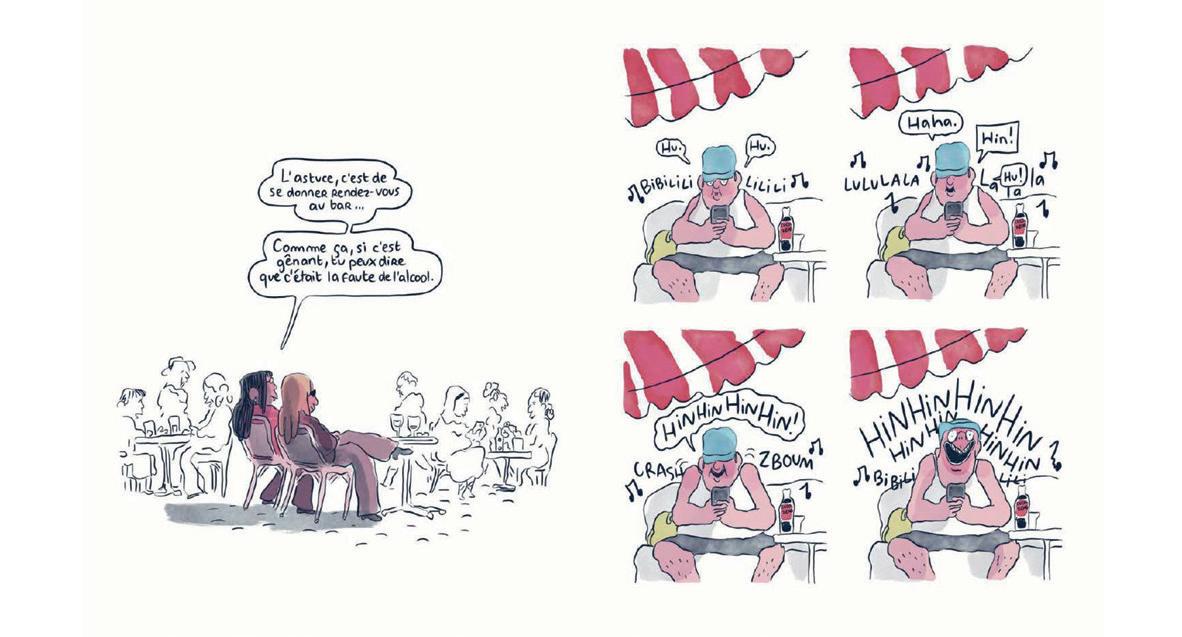

Essay. 10
Cyril Dion , La Lutte enchantée 10
> le souffle de l’esprit.
Carolyn Carlson, Un saut dans le bleu 11
Alain Sainte-Marie, Prières d’écrivains 11
Pierre Tallet , Cuisine et saveurs de l’Égypte ancienne 12
Hubert Voiry, 10 champignons qui ont changé la vie des hommes. 13
> arts équestres.
Nuno Oliveira and Jean-Louis Sauvat , Dialogue équestre 14
Laurence Paoli, Le Chant perdu des baleines 15
> mondes sauvages.
Caroline Audibert , Les Audionautes 15
Corentin de Chatelperron, L’Appart’ du futur 16
> je passe à l’acte.
Julia Zimmerlich, S’impliquer dans sa commune 17
> Co-publication with Radio France

lutter !)
[The Enchanted Struggle – How to Stay Optimistic (and struggle!) in a World on the Brink]
‘I’m going to talk about everything you’re not supposed to talk about on the morning show. I’m going to share what’s on my mind and how I think we can sort things out.’ In August 2024, Cyril Dion agreed to do a Wednesday morning guest slot on France Inter radio station. This is a collection of her contributions, which joyfully plunder every disciplinary field imaginable. There is talk of civil disobedience, the politics of the environment, democracy, mental health, algorithms, capitalism, plastics, dead fish, dog turds and strategies for opposing a pipeline or toppling a dictator, as well as space for poetry, the Beatles and love. The message of the book is that small gestures are not enough to change a system that is loaded against us, but that we can nevertheless try to change the rules of the game.
Until 2013, Cyril Dion ran the Colibris citizens’ movement, which he set up with the farmer and philosopher Pierre Rabhi. With Mélanie Laurent, he co-directed the film Demain, which won the César for best documentary in 2015. Despite scientists’ dire warnings about the future, the film is notable for its refusal to lapse into terminal pessimism. Instead, it adopts an optimistic perspective as it focuses on initiatives in ten countries to contend with the environmental and social challenges of the 21st century in fields as diverse as agriculture, energy, the economy, education and governance.
He published his first poetry collection, Assis sur le fil, in 2014 (La Table ronde). In 2018, he published his Petit manuel de résistance contemporaine with Actes Sud, and in 2019 he was one of the guarantors of the independence of the Citizens’ Convention for the Climate. In 2021, he made the film Animal about the mass extinction of species, which was entered into the special ‘Cinema for the Climate’ category at the Cannes Film Festival in 2021. In September 2024, he joined the ‘La Terre au Carré’ team on France Inter, affording him a regular radio slot.
[Leap into the Blue]
Translated from English (United States) by Jean-Pierre Siméon

In addition to her choreography, Carolyn Carlson is a poet and calligrapher. Following on from Le Soi et le Rien in 2002 and Brins d’herbe in 2011, ? is her third book of poetry to be published in the ‘Le Souffle de l’esprit’ collection. Her trademark sense of image and rhythm and her elliptical style are perfectly complemented by the two dynamic calligraphies she has created specially for this book.
Carolyn Carlson has created some one hundred shows, many of which have been landmarks in the history of dance. Her life’s work was recognised in 2006 when she became the first choreographer to be awarded the Golden Lion at the Venice Biennale. In 1999, she founded the Atelier de Paris – Carolyn Carlson à la Cartoucherie, from 2004 to 2013, she ran the Centre Chorégraphique National de Roubaix Hauts-de-France. Together with the Carolyn Carlson Company, she was associate artist at the Théâtre National de Chaillot from 2014 to 2016.
[Writers’ Prayers - Selected Texts]
Texts selected and translated from English by Alain Sainte-Marie

Prières d’écrivains takes us into the minds of internationally recognised writers who have aspired to the absolute, courtesy of selected texts that are not confessional in the religious sense but do carry a strong poetic charge. They are contextualised by an introduction that posits prayer as a human phenomenon that transcends geographical borders. Though it makes no claims to being exhaustive, this book nevertheless offers a broad panorama of the literature of Europe and beyond, reflecting a rich literary heritage that is epitomised by outstanding passages from Fyodor Dostoevsky, Emily Dickinson, Henry Bauchau and Antonin Artaud among others.
Born in 1969, Alain Sainte-Marie is a writer (Le Flux de la vie, Les Deux Océans, 2016; Le Grand Ailleurs, Accarias, 2019; Origine, Unicité, 2021), a translator and a radio presenter (‘À mots couverts’). A regular contributor to the ‘Le Souffle de l’esprit’ collection, for Actes Sud he has translated Flannery O’Connor’s A Prayer Journal, various essays by Wendell Berry and The Fury of Beautiful Things by Akram Khan. He lives and works in the Auvergne region of central France.
11,5 × 17 cm / 64 pages October 2025
> Le Souffle de l’esprit
11,5 × 17 cm / 192 pages October 2025
> Le Souffle de l’esprit
24 cm / 184

[The Cuisine and Tastes of Ancient Egypt]
Extant Egyptian documents tell us how basic foods were prepared and the mindset behind the cooking of dishes. But there are no actual recipes, meaning that we can only guess at what precisely featured on the table of an Ancient Egyptian, whether of the pharaoh and his entourage or the average subject. But there would have been bread and cakes, meat and fish, fruit and vegetables, sugar and spices, and oils and drinks of various kinds. We can deduce this from ancient Red Sea papyri that provide details of what the builders of the Great Pyramid of Giza ate. On the basis of the available data, this book serves up some thirty simple recipes that offer us the chance to eat, banquet and get merry just as the ancient pharaohs did!
Pierre Tallet, a graduate of the prestigious École Normale Supérieure in Paris, is a doctor of Egyptology and teacher of history. He has led various digs in Egypt, including at the sites of the ancient Wadi al-Jarf and Ayn Sukhna harbours on the Red Sea coast and on the Sinai Peninsula. He currently holds the chair of Egyptology at the Sorbonne and is the director of the Institut Français d’Archéologie Orientale in Cairo. He is the author of Les Papyrus de la mer Rouge L’inspecteur Merer : un témoin oculaire de la construction des pyramides de Chéops (Actes Sud, 2021).
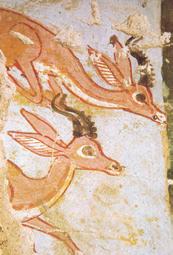

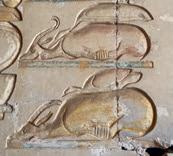
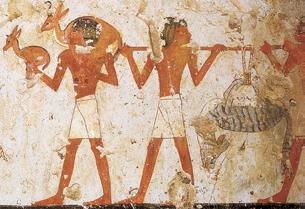
Une table d’offrandes plus imagée que les autres donne toutefois une illustration de la plupart des pièces de boucherie, accompagnées d’une légende. Le même traitement est réservé à d’autres animaux, sauvages cette fois, qui sont manifestement élevés et gavés pour être ensuite savourés il s’agit de gazelles et de différents types d’antilopes (oryx, addax, ibex) que l’on retrouve figurés à plusieurs reprises dans les bas-reliefs funéraires. Mais l’alimentation égyptienne s’enrichit visiblement d’autres proies sauvages, moins attendues le plus surprenant est la représentation fréquente e hyènes dans le répertoire égyptien. Certes, on ne voit jamais de scène d’abattage et de dépeçage les concernant. Le fait, cependant, qu’on ait pu les entretenir en captivité, voire les gaver – ce qui apparaît clairement dans le mastaba de Mererouka, où T Retour de la chasse on ramène des gazelles et une hyène dynastie, tombe d’Amenemopet, Gournet el-Mourraï, Thèbes-Ouest (TT 276). Gazelles traquées lors d’une partie de chasse dans le désert. dynastie, tombe d’Amenemopet, Gournet el-Mourraï, Thèbes-Ouest (TT 276). Lièvre apeuré, fermement saisi par un chasseur. XVIII dynastie, tombe d’Amenemopet, Gournet el-Mourraï, Thèbes-Ouest (TT 276). Gazelles entières (et canards délicatement posées sur elles !) sur la table des offrandes cultuelles. XIX dynastie, temple de Ramsès II, Abydos.
V Pêcheur à la ligne et pêcheur au haveneau. VI dynastie, mastaba de la princesse Idout, Saqqara-Nord, d’après Daumas, 1964, fig. 4.
Un pêcheur arrache l’épine dorsale d’un synodontis. dynastie, mastaba de Ti, Saqqara-Nord, d’après Daumas, in Bifao 62, 1964, fig. 11. W Pêcheur à la ligne. VI dynastie, mastaba de Mererouka, Saqqara-Nord, d’après Daumas, in Bifao 62, 1964, fig. 7.

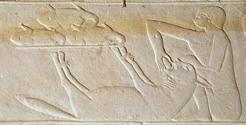
nature éclectiques dans leurs habitudes culinaires, les Égyptiens de l’Antiquité mangent certainement aussi des hérissons, des lièvres, voire de plus petites proies, comme les souris, dont on a parfois retrouvé les ossements dans l’estomac des momies Différents types d’oiseaux sont également cuisinés avec une grande régularité. Deux volailles apparaissent le plus souvent dans les sources les oies et les canards les poulets, quant à eux, ne semblent pas avoir été connus en Égypte avant l’époque gréco-romaine, où ils sont vraisemblablement importés d’Europe. Les oies – dont on connaît une dizaine d’espèces en Égypte pharaonique – sont élevées en troupeaux par un personnel spécialisé et sont populaires, autant pour la consommation de leur chair que pour leur faculté à assimiler de la graisse. Ce produit est en effet couramment utilisé aussi bien dans la cuisine que pour la confection de potions médicinales. Peut-être est-ce la raison pour laquelle on connaît tant de scènes de gavage de ces volatiles – il
dynastie, mastaba de Mererouka, Saqqara-Nord. Y VI dynastie, mastaba de Kagemni, Saqqara-Nord (LS 10). X Une très belle prise de canards sauvages ! XVIII dynastie, tombe d’Amenemhab, Cheikh Abd el-Gourna, Thèbes-Ouest (TT 85).

96 La Cuisine des pharaons
97 La consommation du poisson

d’un petit gourdin pour assommer sa proie lorsqu’il la tire hors de l’eau. Tous les spécimens qui sont représentés sur les monuments égyptiens sont des poissons du Nil ils ont depuis longtemps été identifiés grâce à la précision du dessin qui en a été fait. On trouve ainsi parmi eux des poissons-chats, des carpes, des perches, des tilapias… L’une des prises les plus appréciées est manifestement le mulet (ou muge), un poisson de mer qui remonte le Nil, dont les œufs sont utilisés pour faire la poutargue (voir infra). Après avoir été pêché, le poisson connaît différents types de traitements être immédiatement préparé pour la consommation ou bien encore être séché pour une conservation prolongée. La seconde méthode est couramment employée on sait en effet que les poissons séchés sont livrés avec une grande régularité aux ouvriers de Deir el-Medina ; cette denrée vient, selon les comptes retrouvés dans le village, juste après le pain et les céréales. Nul doute qu’elle constitue le principal apport en protéines de l’alimentation du peuple. Les étapes de la préparation du
T Pêcheur à la ligne et pêcheur au haveneau : on distingue très bien le hameçon et l’index du pêcheur tendu sur la corde pour lui signaler quand le poisson a mordu. VI dynastie, mastaba de Kagemni, SaqqaraNord (LS 10).
Illustrations by Guillaume Reynard

If, instead of describing and categorising mushrooms, we tell their story, it becomes clear just how central a role they have played since the very dawn of mankind. There are ones who sank the English fleet in the 19th century and the one that led to hundreds of women being burnt at the stake, but also more prosaically the ones that helped us light the first fires, healed our wounds and blighted our homes. This little book, illustrated like a fairy tale, tells the story of the amanitas, the tinder fungus, the dry rot and ergot fungi, the humble oyster mushroom and the other small and large mushrooms that have always lived among us and have sometimes changed the course of our lives.
Hubert Voiry is a forester and mycologist who from a young age took an interest in the relationship between fungi and forests. After a long career at the Office National des Forêts where he spent 25 years teaching foresters about the role played by mushrooms in the forest ecosystem, in 2017 he was seconded to the French National Museum of Natural History.
Guillaume Reynard is an illustrator based in Paris who has worked with various publishing houses on comic albums aimed at a young readership and on graphic novels. He also illustrates reports and features for daily newspapers and magazines. His illustrations are used by public bodies, PR and advertising agencies, and even winegrowers. He has illustrated many novels and non-fiction books for Actes Sud Jeunesse.

> Equestrian arts

[Equestrian Dialogue]
When students and disciples of the pre-eminent Portuguese horse trainer Nuno Oliveira (1925- 1989) urged him to author a manual for posterity explaining how he managed to realise the full potential of his horses, his response was to ask one of them – the sculptor Jean-Louis Sauvat, himself a fine rider – to create drawings to illustrate the principal stages of training a horse. Oliveira’s idea was that he would then add comments to these sketches made during actual training sessions. This original approach involving a collaboration between a horseman and an artist should come as no surprise, as Oliveira always believed that horsemanship was an art. And he agreed with Napoleon that a good drawing was worth a thousand words.
Nuno Oliveira (1925-1989) was born in Lisbon. He learnt to ride at a very early age, and by the time he was 23 he was acknowledged as a leading trainer of horses and horseriders. His reputation soon spread abroad, and in 1967 he gave his first lessons outside Portugal, rapidly becoming a master of the French style of horseriding and its technical and artistic traditions. He authored several books, which were published as his collected works in 2006 (initially by Belin and then by Vigot). An insightful addition was published in 2021: Les Écrits de jeunesse de Nuno Oliveira (1951-1956), with an introduction by Jean Magnan de Bornier (Actes Sud).
A sculptor, illustrator and painter, as well as being a keen horserider, Jean-Louis Sauvat lives and works in the Perche region, not far from Chartres. Born into a family with a long artistic heritage in 1947, he initially trained in arts and crafts and subsequently in the fine arts. Horses occupy a central place in his oeuvre. An accomplished horse trainer himself, his daily horse rides feed into his creative endeavours.

Quand la pollution sonore étouffe les voix de l’Océan
[The Lost Whalesong – How sound pollution is drowning out the voice of the oceans]
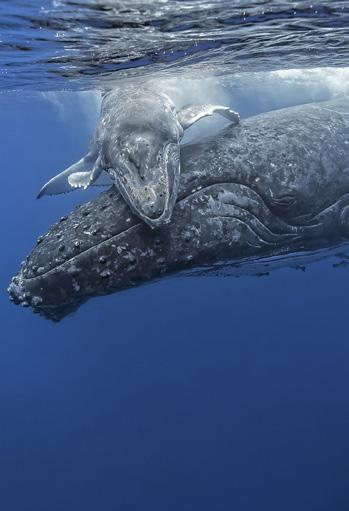
The silent world of the sea is in fact anything but silent. Sea creatures deploy all kinds of sonic strategies to orientate themselves, feed and mate. But when human beings jam communications with the din of the machines they use in fishing, freight, watersports, military exercises, seismic prospecting, offshore facilities and the like, the sound pollution considerably disrupts subaquatic ecosystems and is contributing to the current collapse of biodiversity. This is the first in-depth investigation into this fraught subject, which is nevertheless treated with a lightness of tone and a healthy dose of humour.
Laurence Paoli set up and ran the first communications department devoted to conservation and animal biodiversity at the French National Museum of Natural History in Paris before going on to found Urban Nomad, a PR consultancy specialising in life and earth science. She now devotes her time to writing and has published with Buchet-Chastel two popular science essays: Zoos. Un nouveau pacte avec la nature in 2019 and Quand les animaux nous font du bien. Enquête sur ces compagnons qui rendent nos vies meilleures in 2022.
Sur les traces des chants de la Terre
[The Audionauts – Tracking the Songs of the Earth]

What if our current lack of awareness of the living world were down to our deafness to the thousand and one voices emanating from the Earth? This is the starting assumption of the writer and naturalist Caroline Audibert as she sets out to interview those who are still sensitive to the murmur of the plant and animal worlds and the elements, or as she calls them the audionauts. In the course of her peregrinations across the Alps, the Amazon rainforest, the Russian taiga and the most damaged places on the planet, taking in hightech laboratories along the way, her ears become increasingly receptive and she comes to appreciate more fully the connections that characterise ecology and the need to repair the damage done.
Caroline Audibert’s blend of non-fiction and nature writing might aptly be described as geopoetical. A philosopher by training and a writer and journalist by trade, she is the author of Des loups et des hommes (Plon, ‘Terre humaine’, 2018, Prix 30 Millions d’Amis) and of the novel Nés de la nuit (Plon, 2020, shortlisted for the Prix Roblès and winner of the Prix Pauline de Simiane), in which she experiments with the ‘language of the wild’. She lives in Nice between the Mercantour National Park and the Mediterranean Sea.
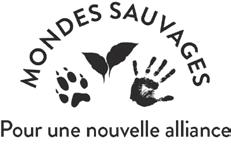
> Co-publication with Arte
[The Apartment of the Future – Low-tech adventures in the urban biosphere]
A shower that doubles up as a mushroom fruiting chamber, a worktop from which hydroponically and organically grown aromatic herbs sprout, a mechanical grinder for waste, and an energy-efficient pressure cooker – welcome to the apartment of the future! Corentin de Chatelperron, an engineer, researcher, sailor and adventurer, has taken inspiration from the innovations he has come across in some twenty countries around the world that make it possible to live in a more resilient fashion. He has also drawn on his shared experiences of alternative lifestyles at sea and in the desert to transform a 26m2 studio in the suburbs of Paris into a veritable low-tech laboratory. The aim of this ‘urban biosphere’, which conforms to a rigorous scientific protocol and is complemented by a citizen science programme, is to test and refine a way of living that generates resources instead of waste, consumes limited energy, and is well within the reach of the average budget.
This book, like his web series L’Appart’ low-tech – Bienvenue dans la ‘bios- phère urbaine’ broadcast on arte.tv, is all about sharing his experiences. Adopting an accessible tone to explain the concrete science behind these experiments, and with the help of practical and amusing sketches, Corentin de Chatel serves up an ambitious but reader-friendly manual. Realistic in his expectations, refreshingly honest about his doubts, and consistently encouraging, he shows us the way forward to the apartment of the future.
Born in 1983 and an engineer by training, Corentin de Chatelperron has sailed the world aboard a ship cum laboratory, discovering along the way innovative lowtech technologies. Since 2024, he has been experimenting with a new approach to urban living with his ‘Biosphere Experience’. He has published several books and made a number of films and series, including L’Expérience biosphère : 120 jours dans le désert, Arte, 2023. He lives in Brittany.

[Getting Involved in the Local Community]
Illustrations by Anne-Sophie Hellard
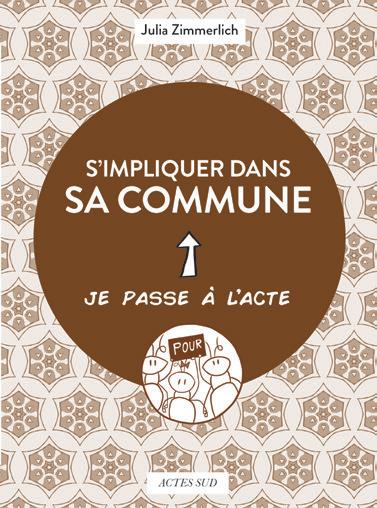
If you find yourself tempted to play a more active role in your local community, then your instincts are sound because the future will depend to a large extent on what happens at the local level. Though the guiding principles for climate action are decided at the national or European level, they take concrete form locally, whether it be as initiatives to restore biodiversity, protect remarkable trees, create cycle paths, support non-industrial farming, source food locally or curb excessive property development schemes.
Drawing on her time as a municipal councillor in a commune of 4,000 inhabitants and her extensive experience of the NGO world, as well as her own research into grass-roots activism, Julia Zimmerlich argues passionately that cooperation between locally elected officials, citizens and NGOs is an indispensable driver of change. Whether it be for an hour a month, part-time or more, discover all the ways you can help depending on your interests and your availability. This might include joining or setting up a sustainable collective near you to translate your ideas into action.
Julia Zimmerlich, a specialist in climate and environmental issues, worked as a journalist for various media outlets for a decade. As a socially engaged citizen and a municipal councillor, she now focuses on promoting innovation in public policymaking. She lives in Carignan-de-Bordeaux in south-western France.
A trained architect, Anne-Sophie Hellard specialises in creating images of architectural projects and urban planning and landscaping schemes. She also deploys her drawing talents to illustrate books aimed at a young readership in a minimalist style characterised by playfulness, directness and a certain poetry.
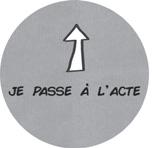
Illustrated books. 20
Yann Arthus-Bertrand and Hervé Le Bras, France, un album de famille 20
Philippe Dumas, Fils Hermès 21
Fine arts. 22
Baptiste Morizot , Le Regard perdu 22
Music. 22
Alexis Brodsky, Jérôme Duval-Hamel and the Art faber Collective, La Muse méconnue de Maurice Ravel 22
Cinema. 23
> actes sud | institut lumière.
Thierry Frémaux, L’Aventure Lumière 23

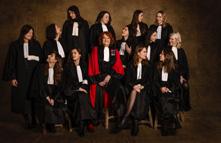






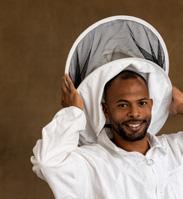







For more than thirty years, Yann Arthus-Bertrand has been photographing the French and other residents of France. In this book, they have all been captured in their everyday or work clothes against a hessian cloth backdrop. The resulting visual and sensory panorama highlights the sheer diversity of France’s population. The 800 photographs, accompanied by texts by Hervé Le Bras, also reflect the need for more subjective representations of the country than those afforded by official socio-economic classifications.
A photographer, film director and president of the GoodPlanet foundation, Yann Arthus-Bertrand champions a humanist form of ecology through his passionate engagement with the animal world and natural spaces. He is the author of the bestselling La Terre vue du ciel and has made numerous documentaries aimed at raising awareness of environmental issues. His most recent book, Devenir cheval, was published by Actes Sud in 2024. He lives and works in Paris.
Hervé Le Bras is a historian, demographer, director of studies at the School for Advanced Studies in the Social Sciences (EHESS) and director of research at the French Institute for Demographic Studies (INED). In the past, he has run the review Population and the historical demography laboratory at the CNRS, and he also chaired the academic board of the regional development authority Datar. He has written some forty books on demographics, the history of populations, and moral and political opinions observed in detail at a regional level. He lives and works in Paris.



travailler. Le trait manque de force. Confiez-moi ça, je vais voir ce que je peux en faire.” La démonstration qui s’ensuivit fut pour moi accablante. Elle faisait appel à des moyens totalement hors de ma portée. Après retouche, c’était bien mon dessin, mais transformé par miracle. Pas de doute, il n’y avait au monde qu’Hugo Grygkar pour être capable de ça : les grands artistes sont une engeance décourageante. Sur ces entrefaites, un troisième homme se joignit au tandem : Philippe Ledoux, illustrateur assez connu. Il vivait à la campagne et affichait le genre gentleman farmer : difficile de dire si sa pointe d’accent lui venait de son éducation dans les public schools d’outreManche, d’un défaut de mâchoire, ou d’une tendance au snobisme. Sa froideur et sa hauteur agaçaient en tout cas beaucoup Hugo Grygkar. Celui-ci démentait formellement les assertions de son collègue selon quoi il ne travaillait qu’à l’aquarelle. “Tout de même, monsieur Dumas, vous voyez bien que c’est fait à l’aérographe. Pourquoi ne l’avoue-t-il pas ?”
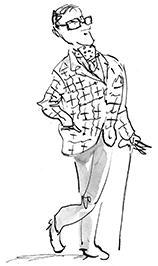

Hugo se servait lui-même volontiers d’un aérographe – celui précisément dont j’hériterais à sa mort et dont je finirais par faire cadeau à un ami, n’ayant jamais réussi à me servir de cet engin. La collaboration avec Ledoux n’était pas une sinécure. Il ne tolérait aucune remarque et se braquait à la moindre suggestion. Il parlait avec la même autorité que son frère, ambassadeur de France, et apostrophait mon père sur le mode : “Eh bien, mon cher, comment va aujourd’hui ? – Très bien, Ledoux. Et vous-même ?” etc. Une fois, pour gagner du temps et éviter des discussions s’annonçant âpres, mon père avait subrepticement fait modifier le travail de Ledoux par un autre artiste.
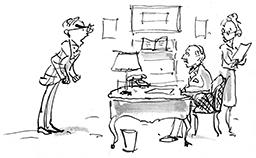
La modification concernait un détail si infime que Ledoux n’était pas censé la détecter. Il la détecta néanmoins et poussa des cris d’orfraie. “Comment ! On se permet de faire retoucher mon œuvre par n’importe quel barbouilleur ? Parfaitement, un barbouilleur !” À sa mort, se présenta son neveu Wladimir Rybalchenko, dont l’apparition et les dons artistiques surprirent d’autant plus que le défunt n’avait jamais soufflé mot d’un quelconque neveu. Réciproquement celui-ci n’avait jamais ouï dire que son oncle travaillât pour Hermès. Philippe Ledoux abusait du droit qu’a tout homme d’être discret.
[Son of Hermès]
Philippe Dumas is not only a talented illustrator in his own right but also the grandson of Émile Hermès, who was instrumental in expanding the eponymous luxury company. In this droll and elegantly illustrated book, he draws on his memories to narrate in his own unique fashion the story of this unusual family. Colourful personalities abound, as well as anecdotes imbued with the smell of leather. As an accomplished artist, he brings to life his childhood memories and a whole gallery of characters in wry and vivid illustrations and delicate and moving wash drawings.
Philippe Dumas has written and illustrated numerous books that have achieved international success and was awarded the Grand Prix de Littérature de la Ville de Paris for his life’s work. As the grandson of Émile Hermès, he knows the eponymous luxury company inside out. He also published a series of sketchbooks with Actes Sud in 2014: La Mer, L’Exotisme, Les Métamorphoses, La Route, La Vie à l’air libre, Le Soleil, Vivre la France, Vive le cheval and Voyage en Extrême-Orient
17 × 23 cm / 136 pages October 2025

10 × 19 cm / 96 pages
October 2025
> Co-publication with Art faber
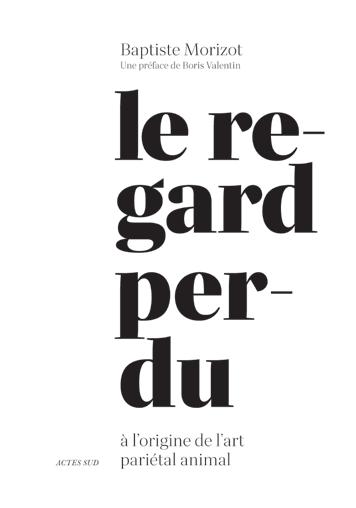
l’origine
[The Lost Gaze – The Origins of Animal Cave Paintings]
Baptiste Morizot invites us to accompany him to the Palaeolithic to rediscover cave paintings and to adopt a fresh perspective on the origins of figurative art. He also reflects on how our specifically Western relationship with the world –our way of seeing and apprehending it – has evolved. Unlike prehistoric Man, we have lost the ability to seize what ornithologists and naturalists call the ‘jizz’ (or essence) of an animal – in other words, the capacity to intuitively and immediately identify it. It is an ability that the author has patiently developed in the course of his field work, and this book is an invitation to rediscover this gaze, which calls into question our certainties about the living world and encourages us to alter our conceptions.
Baptiste Morizot is a philosophy lecturer at the University of Aix-Marseille and a writer. His research, which focuses on the relationship between humans and the living world, is founded on field work often conducted in remote natural environments. He has emerged as one of the leading French environmental thinkers.
[Maurice Ravel’s Secret Muse]
In the early 20th century, artistic representations of the workplace and the business world – these days designated as ‘Art faber’ – proliferated at an unprecedented rate. The industrial world has inspired a broad range of painters, writers, photographers and composers. Of the latter, one of the most important was Maurice Ravel (1875-1937), who became a leading exponent of Art faber in music. Not only Bolero but also many of the works that preceded it were strongly imbued with industrial themes.
Alexis Brodsky is a psychologist, human resources consultant specialising in the industrial sector, a writer about music, a member of the Art faber Collective, and head of research into musical expressions of Art faber at the Arts, Economics & Law Lab of Paris 2 University.
Jérôme Duval-Hamel is a university lecturer, author and president of both the Paris 2 Lab and the Art faber Collective. He also presides over the jury for the Franco-German Cultural Sectors Prize and sits on the board of an international music ensemble.
For more on the Art faber Collective, visit www.artfaber.org.


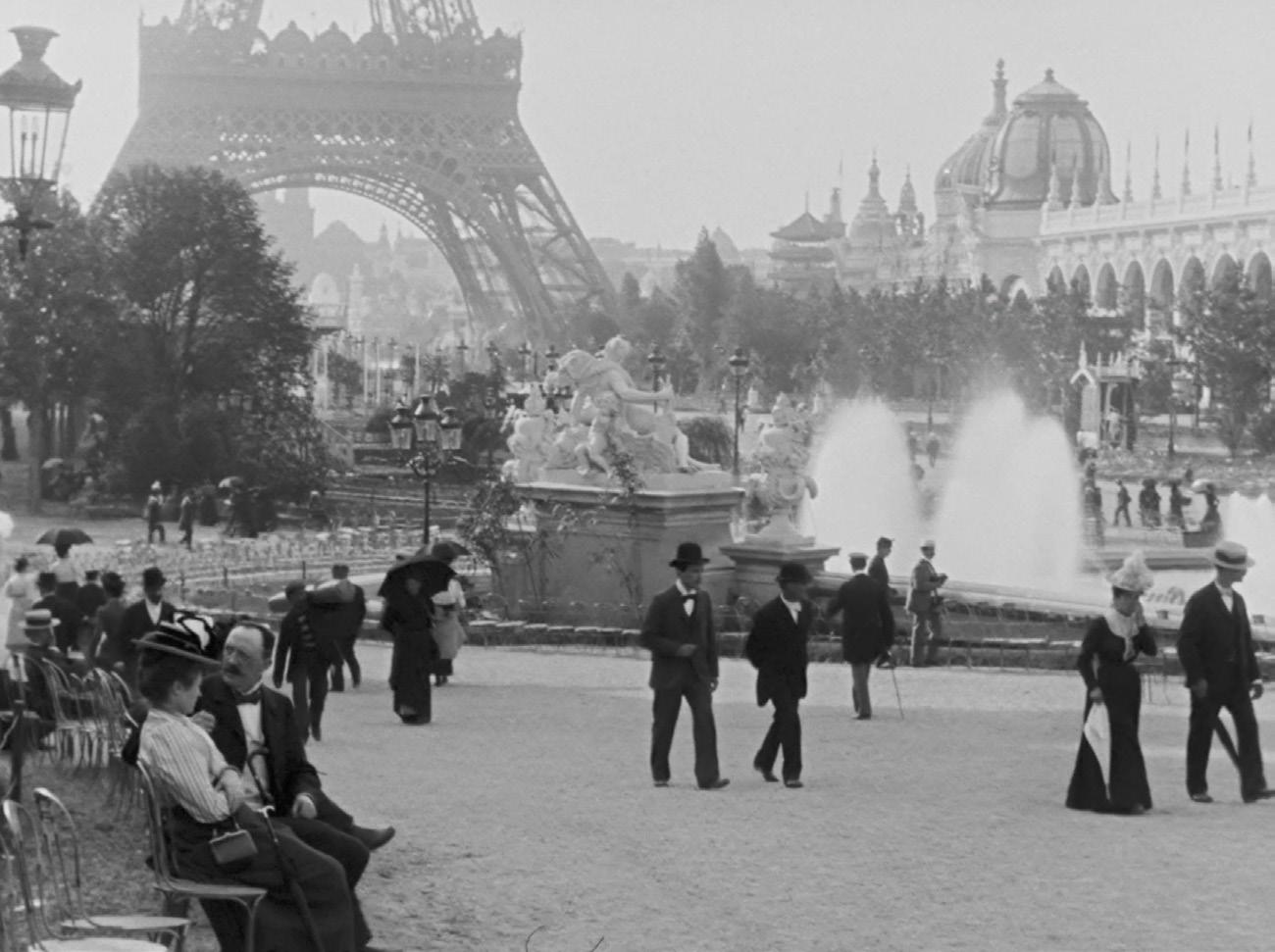
L’Aventure Lumière
[The Lumière Brothers’ Great Adventure]
This illustrated book features the first compilation of Thierry Frémaux’s spoken and written commentaries in the films Lumière, l’aventure commence and Lumière, l’aventure continue, in which he pays homage to the Lumière brothers. Each text accompanies a restored still, affording both a visual and intellectual route back into the very first films ever made. From his own distinctive perspective, Thierry Frémaux conveys his admiration for the sheer creativity of the new cinematic medium and the humanity contained in the images, blending analysis, history and his own emotional responses. This is the story in words and images of the birth of cinema.
Born in 1960 in south-eastern France, Thierry Frémaux runs the Institut Lumière in Lyon and is responsible for the artistic content of the Cannes Film Festival. Together with Bertrand Tavernier (1941-2021), he organised the Centenaire du Cinéma and founded the Festival Lumière. The two men also published a collection devoted to cinema with Actes Sud.
28 × 24 cm / 416 pages October 2025
> Co-publication with Institut Lumière
60-62, avenue de Saxe
75015 Paris
tél. : 01 55 42 63 00
Place Nina-Berberova
13200 Arles
tél. : 04 90 49 86 91
Foreign Rights
Isabelle Alliel
tél. : 04 90 49 56 69 / i.alliel@actes-sud.fr
Sandra Martel
tél. : 04 88 65 90 35 / s.martel@actes-sud.fr
